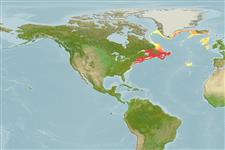Preferred temperature (Ref.
123201): 1.2 - 7.8, mean 4.8 °C (based on 160 cells).
Phylogenetic diversity index (Ref.
82804): PD
50 = 0.5044 [Uniqueness, from 0.5 = low to 2.0 = high].
Bayesian length-weight: a=0.00398 (0.00336 - 0.00471), b=3.16 (3.11 - 3.21), in cm total length, based on LWR estimates for this species (Ref.
93245).
Trophic level (Ref.
69278): 4.3 ±0.5 se; based on diet studies.
Generation time: 10.4 ( na - na) years. Estimated as median ln(3)/K based on 2
growth studies.
Widerstandsfähigkeit (Ref.
120179): niedrig, Verdopplung der Population dauert 4,5 - 14 Jahre. (K=0.11; tm=2; tmax=23; Fec=1 million).
Prior r = 0.40, 95% CL = 0.26 - 0.59, Based on 3 full stock assessments.
Fishing Vulnerability (Ref.
59153): High to very high vulnerability (72 of 100).
🛈
Climate Vulnerability (Ref.
125649): Moderate to high vulnerability (53 of 100).
🛈
Nutrients (Ref.
124155): Calcium = 15.8 [9.1, 31.6] mg/100g; Iron = 0.316 [0.184, 0.544] mg/100g; Protein = 18.1 [16.8, 19.4] %; Omega3 = 0.602 [0.318, 1.095] g/100g; Selenium = 25.5 [14.3, 49.2] μg/100g; VitaminA = 12.8 [3.9, 41.9] μg/100g; Zinc = 0.325 [0.235, 0.457] mg/100g (wet weight);
